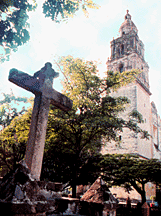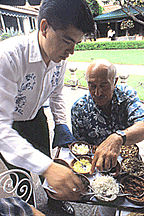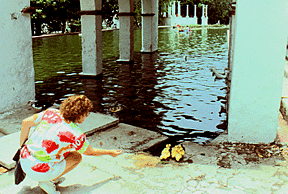CUERNAVACA--THE
TOWN WHERE MEXICAN TOURISM BEGAN
by Bob
Brooke
 Long
before Cancun, long before the luxurious resorts of the Caribbean, long
before spas like the Golden Door, Cuernavaca has been catering to glitzy
people. Long
before Cancun, long before the luxurious resorts of the Caribbean, long
before spas like the Golden Door, Cuernavaca has been catering to glitzy
people.
Ninety years before the Pilgrims landed at
Plymouth Rock, the conquistadores, led by Hernan Cortes, were building a
cathedral in Cuernavaca. It still stands and at sunset, you can see
brilliant shafts of sunlight streaming through its stained-glass windows
to bathe the interior in golden light. Outside, Norfolk pines and palms
stretch to the heavens, nurtured by the gentle spring-like climate of
this sanctuary city an hour's drive from Mexico City.
For over 400 years, it has been a favorite
retreat of Aztec kings, conquistadores, and hundreds of American and
European expatriates. It is also a weekend hejira(escape) for
middle-class residents of Mexico City, who bring with them their
families and, of course, their cars, which are polluting the
sweet-smelling air.
City Awarded to
Cortes
The Aztecs named it Cuauhnahuac, which the Spanish found unpronounceable
when they arrived in 1521. To their ears, it sounded like "cow's
horn," and so it became Cuerna de Vaca, later shortened to
Cuernavaca. The city was one of 30 awarded to Cortes by the Spanish
king, and he chose it as his retirement home, though he unfortunately
died in Spain in 1547 before he could return to it.
Like many Mexican "towns," Cuernavaca
sounds as if it is a small romantic village in the mountains. Though
this may have been so when it was discovered by Americans in the 1950's,
today it is a bustling city whose population swells to three times its
size on weekends.
This is no small wonder, for at 5,000 feet, the
city has springlike weather all year long. When it's cold and rainy in
Mexico City at 7,200 feet, the swimming pools of Cuernavaca glitter in
the sun. Here, you'll find thermal hot springs and mineral waters,
traditionally soothing for rheumatism and other ailments of the joints
and incredibly relaxing and restorative to the spirit, even if your
joints are in perfect condition. These springs are what drew the Aztecs
to Cuernavaca in the first place.
Cuernavaca has seen the famous and infamous.
From Ferdinand Maxmillian, ordained by the French as emperor of Mexico,
and his wife Carlotta of Belgium, who spent week- ends here, to Charles
Lindbergh, who married the daughter of the American ambassador to
Mexico, Dwight Morrow, the city has played host to many.
The famous last scene in the film, "Butch
Cassidy and the Sundance Kid," where the outlaws were gunned downed
by the Bolivian Army, was shot here, as were several other classic
Hollywood movies.
Splendid Resorts
Await Visitors
 You'll
find no grand hotels soaring out of the hilly city, but splendid resorts
tucked away in gentle green corners. Often they are set on former
haciendas, as there were many large sugar plantations in the area, or in
private parks secluded from the traffic and noise of the city center. You'll
find no grand hotels soaring out of the hilly city, but splendid resorts
tucked away in gentle green corners. Often they are set on former
haciendas, as there were many large sugar plantations in the area, or in
private parks secluded from the traffic and noise of the city center.
One of the most luxurious in town is the
Cuernavaca Racquet Club, an exclusive tennis resort. Nine tennis
courts(four lighted for night play) are laid out among the flame trees,
sea grape, and hibiscus. The Peter Burwash system of tennis instruction
is used and facilities are kept in top condition. The club also
functions as a hotel, with 80 suites laid out on three landscsaped
levels. All are hung with terraces facing the southern sun andare
equipped with fireplaces to warm the hint of mountainous chill. Rates
are $150 per day, including tennis.
Posada Jacarandas offers a variety of
accommodations, including a tree house "lovenest" for
honeymooners, 65 rooms, and suites in separate cottages. Of the 2,000
plus pools in Cuernavaca, this resort has two, one of them deep in a
green grotto, as well as a small six-hole 3-par golf course and
badminton courts. Rooms are about $50 a day.
The Palace of
Cortes
Just east of the Palace of Cortes downtown is the Hosteria Las Qunitas.
Its spacious lawns, set with huge trees, are rimmed by 45 colonial-style
rooms with purple bougainvillea spilling from the red-tiled roofs;
suites are in attractive pink casitas(small cottages). Rates here are
also about $50 per night.
But you won't come to Cuernavaca to sit by the
pool all day. Cuernavaca has it share of interesting sites. Perhaps the
most impressive is the Museo Cuauhnahuac, or Cortes' Palace on the main
square, the Jardin Los Hereos.
Intended by Cortes to be a fortress, this
rather forbidding structure was used for many years to house the state
government offices. Today is serves as a state museum showing the
history of the State of Morelos, as well as Diego Rivera murals
depicting the conquest of Mexico. You'll also get good views of the city
from third floor terrace and the roof. As was customary during the
sixteenth century, the Spaniards chose to build their most important
structures on top of existing Aztec buildings. The remains of the
Tlauican pyramid are visible in the front of the palace.
Strolling the
Borda Gardens
 From
here it's a short walk to the Avenida Morelos and the Borda Gardens,
famous as the summer home of Maxmillian and Carlotta. Opposite this
enclosed garden complex is the Cathedral de San Francisco, founded by
Cortes in 1529 and one of the oldest churches in Mexico. Originally part
of a Franciscan monastery housing missionaries enroute to the Far East
via Acapulco. A massive mural, uncovered in 1983, depicts the
crucifixion of St. Felipe and his fellow missionaries in Nagaski, Japan
in 1597. The Mariachi Mass at 11 a.m. on Sundays is famous all over
Mexico; be sure to get there early if you want a seat. From
here it's a short walk to the Avenida Morelos and the Borda Gardens,
famous as the summer home of Maxmillian and Carlotta. Opposite this
enclosed garden complex is the Cathedral de San Francisco, founded by
Cortes in 1529 and one of the oldest churches in Mexico. Originally part
of a Franciscan monastery housing missionaries enroute to the Far East
via Acapulco. A massive mural, uncovered in 1983, depicts the
crucifixion of St. Felipe and his fellow missionaries in Nagaski, Japan
in 1597. The Mariachi Mass at 11 a.m. on Sundays is famous all over
Mexico; be sure to get there early if you want a seat.
But when you visit Cuernavaca, you will
undoubtedly be impressed by its flowers before you get any sense of its
history. Geraniums reach to rooftops; fushia and red and coral
bougainvillea grwo wild. The bluish-lavendar jacaranda and flaming
poinciana tint the air with color. Beyond the city are groves of banana
trees, mangoes, guavas. limes and oranges. If you don't fall in love
with Cuernavaca, you'll at least understand why so many people
throughout hisotry have been so attached to this place. |

